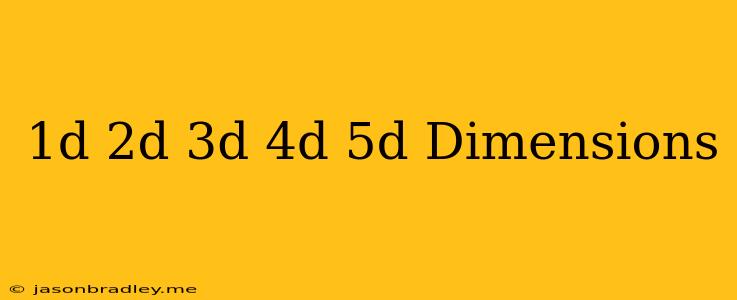Dimensions: From 1D to 5D and Beyond
Understanding dimensions is crucial in various fields, from physics and mathematics to philosophy and even science fiction. Let's delve into the concept of dimensions, starting with the familiar and moving towards the abstract.
1D: The Line
The simplest dimension is one-dimensional, represented by a straight line. In 1D, objects can only move forward or backward. Think of a single point moving along a ruler.
2D: The Plane
Two-dimensional space allows for movement in two directions - length and width. Imagine a flat surface like a sheet of paper, where objects can move horizontally and vertically. This is the world we experience in everyday life, where we can walk left or right and forward or backward.
3D: The World We Know
The three-dimensional world is the one we perceive and interact with every day. Here, we can move up and down, left and right, and forward and backward. This dimension encompasses length, width, and height.
4D: Time Enters the Equation
Four-dimensional space adds time as a fourth dimension to the familiar three dimensions of space. This is where Einstein's theory of relativity comes into play. In 4D, objects can move through space and time. We experience this dimension as the present and the flow of time.
5D: A Higher Reality
Five dimensions and beyond are highly theoretical and abstract concepts. The most common way to think about 5D is to imagine it as a parallel universe existing alongside our own 4D reality. In 5D, objects could move through multiple parallel universes.
Beyond 5D: String Theory and Beyond
The concept of higher dimensions is explored in string theory, which proposes that the universe is made up of tiny vibrating strings in 10 or 11 dimensions. These theories remain highly speculative and are yet to be experimentally proven.
Applications and Implications
Understanding dimensions has far-reaching applications. In physics, it's crucial for understanding concepts like gravity, black holes, and the expansion of the universe. In mathematics, dimensions are essential for geometry and topology. Additionally, these concepts inspire science fiction and philosophy, prompting us to contemplate the nature of reality and the possibility of parallel universes.
While the concept of higher dimensions may seem abstract, it provides a fascinating framework for exploring the universe and our place within it. As our understanding of physics and mathematics continues to advance, our understanding of dimensions may evolve, revealing even more complex and intriguing realities.
